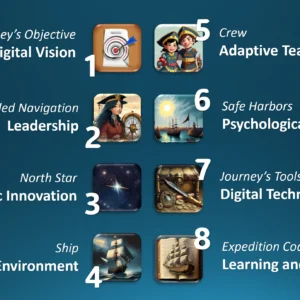Introduction
You’ve assembled a skilled team, but you notice something’s missing. Results.
When a team lacks trust, it’s like sailing a ship with holes in the hull; you might not sink immediately, but you’re not going far. Team members start holding back information, doubting each other’s motives, and avoiding collaboration. This environment makes it challenging to admit mistakes or offer new ideas openly. Over time, these invisible barriers slow down innovation and productivity.
This quick read will explain Psychological Safety and why it is the key for high-performing teams.
Psychological Safety is the sixth pillar of a Successful Digital Transformation Journey.
What to Expect
- A quick guide to understanding what Psychological Safety is and why your team needs it.

What is Psychological Safety?
We all recognize the value of psychological safety in a team setting. It’s our safe harbor, where we can freely admit mistakes, seek help, or share personal challenges without fearing judgment. More than just a comfort zone, it’s a space where members can voice ideas, resolve conflicts, and collaborate without apprehension.
Guided by effective leadership, the team merges its skills and knowledge, paving the way for innovative problem-solving. This environment doesn’t just foster inclusion; it actively combats employee burnout and turns a collective into a dynamic learning team.
Start with Trust
Without trust, your harbor may look calm on the surface, but it won’t hold up when the storms roll in. Trust forms the deep, individual connections between team members. It’s not just about feeling safe within the group; it’s a personal belief that each individual will act with integrity, keep their commitments, and support each other.
When trust is the anchor, something extraordinary happens. Team members feel free to be themselves, to take risks, and to share openly because they believe their teammates will support them, come what may.
Patrick Lencioni’s book “The Five Dysfunctions of a Team” emphasizes trust as the foundation for team success. According to Lencioni, the absence of trust is the first and most fundamental dysfunction that teams face. Without trust, all other elements — healthy conflict, commitment, accountability, and focus on results — become nearly impossible.
The team can tackle conflict head-on when trust and psychological safety are strong. No one avoids tough conversations. Instead, they see them as opportunities for growth, replacing the usual shallow peace with meaningful, passionate debates.
Commitment also runs deep. It’s not just nodding in meetings; it’s genuinely buying into the team’s decisions and strategies. This clarity eliminates any room for ambiguity, keeping everyone focused and united in their mission.
Accountability becomes a team sport. No one hesitates to hold each other to high standards, and dodging responsibility isn’t an option. This fosters an environment where feedback is welcome, raising the bar for everyone involved.
And when it comes to results, it’s all about the team. Personal goals and egos take a back seat to collective outcomes. It’s not ‘I win,’ but ‘we win.’

Building Psychological Safety in Your Team
Psychological safety is the safe harbor every team needs. Here are my three main recommendations for building it.
- Open Communication Channels: Encourage regular meetings where everyone can speak and share their ideas or concerns. Listening actively and acknowledging each team member’s contribution is crucial for fostering a sense of psychological safety.
- Lead by Example: As a manager or team leader, model the behavior you want to see. Openly discussing your mistakes and vulnerabilities can set the tone for the entire team, encouraging a culture where people feel safe to be themselves.
- Non-Judgmental Atmosphere: Create an environment where team members don’t fear punishment or ridicule for sharing their ideas, even if they are not implemented. Make it clear that all ideas are welcome and that constructive criticism is aimed at the idea, not the person.
- Invest in Team Relationships: It’s built through shared experiences, consistent communication, and getting to know each other as individuals, not just roles on a team.
- Clear Roles and Responsibilities: Knowing your role and expectations can significantly reduce stress and confusion, promoting a psychologically safe environment.

Conclusion
High-performing teams aren’t just a result of skilled individuals but come from an environment that fosters trust and psychological safety. When these elements are present, you get a team where open dialogue, genuine commitment, mutual accountability, and collective success become the norm rather than the exception.
As business philosopher Jim Rohn put it:
“The walls we build around us to keep out the sadness also keep out the joy.”
Building a team culture that thrives on trust and psychological safety allows you to tear down these metaphorical walls. It enables team members to bring their whole selves to the table: unguarded, engaged, and poised for collective success.










